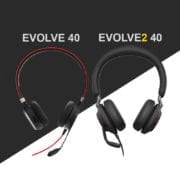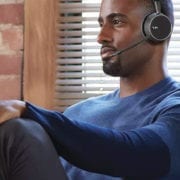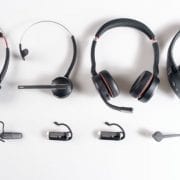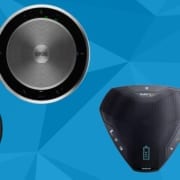What’s the difference between UC and MS Headsets?
Online articles report that as of April 30, 2020, Microsoft Teams had increased its Daily Active Users to 75 million. Leading manufacturers partnered with Microsoft have developed a full line of Microsoft Teams certified devices to support users in individual and group workspaces. Today there are audio & video peripherals, PCs and mobile devices, IP Phones, all-in-one collaboration devices, room systems, and large screen displays all certified for Microsoft Teams.
To keep things short and sweet, we’ll focus on headsets. When it comes to business-grade headsets by Poly, Jabra, EPOS, Logitech, Yealink, and Bose, they all offer UC and Microsoft Teams certified headset models.
What’s the difference between UC and MS headsets? This is a frequently asked question. In this week’s video, we tackle this and four other frequently asked questions when it comes to selecting a UC or MS headset for your environment.
If you are upgrading to Teams from Skype for Business, you won’t need to replace previously replaced devices. All Microsoft certified devices are supported for both Microsoft Teams and Skype for Business. There is one key difference between previously certified devices and it’s the Microsoft Teams button that provides additional functionality.
UC and MS headsets offer multiple wearing styles, USB-A and USB-C connectivity, along with Bluetooth and DECT wireless options to support the various employee types and use cases across organizations.
If you would like to learn which variants are best for your environment, contact us Monday-Friday, 8 am-5 pm ET. In the meantime, get answers to the questions above by watching the video and check out additional videos on our YouTube channel!













 Every day I hear customers requesting “ANC” or “NC” headsets. Some know the difference however many don’t. It’s kind of like “Bluetooth”. To some, “Bluetooth” simply means “wireless”. Whether it’s DECT, 2.4Ghz, 900Mhz is irrelevant to them. They want a “Bluetooth (Wireless)” headset. For this blog, I’m talking about headsets for professional use by Poly (formerly Plantronics), Jabra & Sennheiser.
Every day I hear customers requesting “ANC” or “NC” headsets. Some know the difference however many don’t. It’s kind of like “Bluetooth”. To some, “Bluetooth” simply means “wireless”. Whether it’s DECT, 2.4Ghz, 900Mhz is irrelevant to them. They want a “Bluetooth (Wireless)” headset. For this blog, I’m talking about headsets for professional use by Poly (formerly Plantronics), Jabra & Sennheiser.
